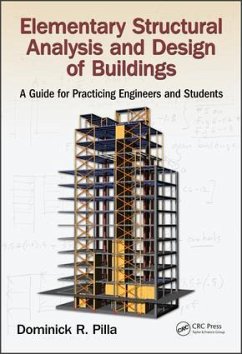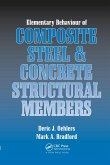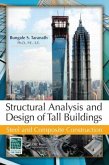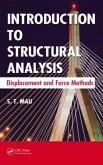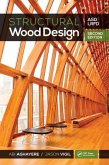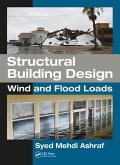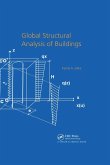Dominick R. Pilla
Elementary Structural Analysis and Design of Buildings
A Guide for Practicing Engineers and Students
Dominick R. Pilla
Elementary Structural Analysis and Design of Buildings
A Guide for Practicing Engineers and Students
- Gebundenes Buch
- Merkliste
- Auf die Merkliste
- Bewerten Bewerten
- Teilen
- Produkt teilen
- Produkterinnerung
- Produkterinnerung
This overview of the analysis and design of buildings runs from basic principles and elementary structural analysis to the selection of structural systems and materials, and on to foundations and retaining structures. It presents a variety of approaches and methodologies while featuring realistic design examples. As a comprehensive guide and desk reference for practicing structural and civil engineers, and for engineering students, it draws on the author's teaching experience at The City College of New York and his work as a design engineer and architect. It is especially useful for those…mehr
Andere Kunden interessierten sich auch für
![Elementary Behaviour of Composite Steel and Concrete Structural Members Elementary Behaviour of Composite Steel and Concrete Structural Members]() Deric J. OehlersElementary Behaviour of Composite Steel and Concrete Structural Members131,99 €
Deric J. OehlersElementary Behaviour of Composite Steel and Concrete Structural Members131,99 €![Structural Analysis and Design of Tall Buildings Structural Analysis and Design of Tall Buildings]() Bungale S. TaranathStructural Analysis and Design of Tall Buildings259,99 €
Bungale S. TaranathStructural Analysis and Design of Tall Buildings259,99 €![Introduction to Structural Analysis Introduction to Structural Analysis]() S. T. MauIntroduction to Structural Analysis170,99 €
S. T. MauIntroduction to Structural Analysis170,99 €![Structural Wood Design Structural Wood Design]() Abi AghayereStructural Wood Design102,99 €
Abi AghayereStructural Wood Design102,99 €![Structural Building Design Structural Building Design]() Syed Mehdi AshrafStructural Building Design167,99 €
Syed Mehdi AshrafStructural Building Design167,99 €![Global Structural Analysis of Buildings Global Structural Analysis of Buildings]() Karoly ZalkaGlobal Structural Analysis of Buildings322,99 €
Karoly ZalkaGlobal Structural Analysis of Buildings322,99 €![Structural Analysis and Design to Prevent Disproportionate Collapse Structural Analysis and Design to Prevent Disproportionate Collapse]() Feng FuStructural Analysis and Design to Prevent Disproportionate Collapse89,99 €
Feng FuStructural Analysis and Design to Prevent Disproportionate Collapse89,99 €-
-
-
This overview of the analysis and design of buildings runs from basic principles and elementary structural analysis to the selection of structural systems and materials, and on to foundations and retaining structures. It presents a variety of approaches and methodologies while featuring realistic design examples. As a comprehensive guide and desk reference for practicing structural and civil engineers, and for engineering students, it draws on the author's teaching experience at The City College of New York and his work as a design engineer and architect. It is especially useful for those taking the National Council of Examiners for Engineering and Surveying SE exam.
Produktdetails
- Produktdetails
- Verlag: CRC Press
- Seitenzahl: 272
- Erscheinungstermin: 1. Dezember 2016
- Englisch
- Abmessung: 260mm x 183mm x 19mm
- Gewicht: 712g
- ISBN-13: 9781498775885
- ISBN-10: 1498775888
- Artikelnr.: 47225140
- Herstellerkennzeichnung
- Libri GmbH
- Europaallee 1
- 36244 Bad Hersfeld
- gpsr@libri.de
- Verlag: CRC Press
- Seitenzahl: 272
- Erscheinungstermin: 1. Dezember 2016
- Englisch
- Abmessung: 260mm x 183mm x 19mm
- Gewicht: 712g
- ISBN-13: 9781498775885
- ISBN-10: 1498775888
- Artikelnr.: 47225140
- Herstellerkennzeichnung
- Libri GmbH
- Europaallee 1
- 36244 Bad Hersfeld
- gpsr@libri.de
Dominick Pilla is an engineer and architect, in both private practice and as an Associate Professor in the School of Architecture at The City College of New York, USA.
1. Minimum Design Loads for Buildings
1.1 Loads
1.2 Dead Loads
1.3 Live Loads
1.3.1 Reduction in Uniform Live loads
1.4 Snow Loads
1.4.1 Flat roof Snow Loads
1.4.2 Minimum Snow Load
1.4.3 Snow Drifts on Lower Roof
1.5 Thermal Loading
1.6 Forces and Loads Due to Soil Pressures
1.6.1 Active and Passive Lateral Pressure
1.6.2 Static Lateral Soil Pressure
1.6.3 Hydrostatic Pressure
1.6.4 Bearing Pressure
2. Wind and Seismic Forces Applied to Buildings
2.1 Lateral Loads
2.2 Wind Loads
2.3 Horizontal Seismic Loads
2.4 Vertical Seismic Load Effect
3. Lateral force Distribution
3.1 Wall Rigidities
3.2 Relative Rigidity Force Distribution (Rigid Diaphragm Analysis)
3.2.1 Center of Mass
3.2.2 Center of Rigidity
3.2.3 Polar Moment of Inertia
3.2.4 Eccentricity
3.2.5 Wall Shears (Direct and Torsional)
3.2.6 Design Wall Shears
3.3 Flexible Diaphragms
3.4 Seismic Static Force Procedure
3.4.1 Equivalent Lateral Force Method
3.5 Horizontal and Vertical Irregularities
4. Methods
4.1 Frame Analysis by Approximate Methods
4.1.1 Analysis of Building Frames for Vertical Loads
4.1.2 Analysis of Building Frames for Lateral Loads
5. Design and Detailing of Structures
5.1 Lateral Force Resisting Systems
5.1.1 Bearing Wall Systems
5.1.2 Building Frame Systems
5.1.3 Moment Resisting Frame Systems
5.1.4 Dual Systems with Special Moment Frames
5.1.5 Dual Systems with Intermediate Moment Frames
5.1.6 Cantilever Column System
5.2 Load Combinations
5.3 Building Drift
5.4 Redundancy Factors
5.5 Overstrength
5.6 Structural systems Integration
6. Steel
6.1 Introduction to Lateral Steel Design
6.2 Special Concentrically Braced Frames
6.2.1 Brace Design
6.2.2 Frame Design
6.2.3 Column Design
6.2.4 Beam Design
7. Concrete
7.1 Introduction to Lateral Concrete Design
7.2 Shear Wall Systems
7.3 Moment Frame Systems
8. Wood
8.1 Introduction to Lateral Wood Design
8.2 Plywood Diaphragm Design
8.3 Shear Walls and Collectors
9. Masonry
9.1 Introduction to Lateral Masonry Design
9.2 Building Wall Design for In-Plane Loads
9.3 Building Wall Design for Out-of-Plane Loads
10. Foundations and Retaining Structures
10.1 Types of Foundations
10.2 Spread Footings
10.2.1 Concentrically Loaded Footings
10.2.2 Eccentrically Loaded Footings
10.3 Mat-Slab Foundations
10.3.1 Combined Footing
10.4 Deep Foundations
10.4.1 Pile Caps
10.5 Retaining Structures
10.5.1 Foundation Walls
10.5.2 Free Standing Cantilevered Retaining Walls
11. Structural Review of Construction
11.1 Construction Administration
11.2 Special Inspections and Structural Observations
1.1 Loads
1.2 Dead Loads
1.3 Live Loads
1.3.1 Reduction in Uniform Live loads
1.4 Snow Loads
1.4.1 Flat roof Snow Loads
1.4.2 Minimum Snow Load
1.4.3 Snow Drifts on Lower Roof
1.5 Thermal Loading
1.6 Forces and Loads Due to Soil Pressures
1.6.1 Active and Passive Lateral Pressure
1.6.2 Static Lateral Soil Pressure
1.6.3 Hydrostatic Pressure
1.6.4 Bearing Pressure
2. Wind and Seismic Forces Applied to Buildings
2.1 Lateral Loads
2.2 Wind Loads
2.3 Horizontal Seismic Loads
2.4 Vertical Seismic Load Effect
3. Lateral force Distribution
3.1 Wall Rigidities
3.2 Relative Rigidity Force Distribution (Rigid Diaphragm Analysis)
3.2.1 Center of Mass
3.2.2 Center of Rigidity
3.2.3 Polar Moment of Inertia
3.2.4 Eccentricity
3.2.5 Wall Shears (Direct and Torsional)
3.2.6 Design Wall Shears
3.3 Flexible Diaphragms
3.4 Seismic Static Force Procedure
3.4.1 Equivalent Lateral Force Method
3.5 Horizontal and Vertical Irregularities
4. Methods
4.1 Frame Analysis by Approximate Methods
4.1.1 Analysis of Building Frames for Vertical Loads
4.1.2 Analysis of Building Frames for Lateral Loads
5. Design and Detailing of Structures
5.1 Lateral Force Resisting Systems
5.1.1 Bearing Wall Systems
5.1.2 Building Frame Systems
5.1.3 Moment Resisting Frame Systems
5.1.4 Dual Systems with Special Moment Frames
5.1.5 Dual Systems with Intermediate Moment Frames
5.1.6 Cantilever Column System
5.2 Load Combinations
5.3 Building Drift
5.4 Redundancy Factors
5.5 Overstrength
5.6 Structural systems Integration
6. Steel
6.1 Introduction to Lateral Steel Design
6.2 Special Concentrically Braced Frames
6.2.1 Brace Design
6.2.2 Frame Design
6.2.3 Column Design
6.2.4 Beam Design
7. Concrete
7.1 Introduction to Lateral Concrete Design
7.2 Shear Wall Systems
7.3 Moment Frame Systems
8. Wood
8.1 Introduction to Lateral Wood Design
8.2 Plywood Diaphragm Design
8.3 Shear Walls and Collectors
9. Masonry
9.1 Introduction to Lateral Masonry Design
9.2 Building Wall Design for In-Plane Loads
9.3 Building Wall Design for Out-of-Plane Loads
10. Foundations and Retaining Structures
10.1 Types of Foundations
10.2 Spread Footings
10.2.1 Concentrically Loaded Footings
10.2.2 Eccentrically Loaded Footings
10.3 Mat-Slab Foundations
10.3.1 Combined Footing
10.4 Deep Foundations
10.4.1 Pile Caps
10.5 Retaining Structures
10.5.1 Foundation Walls
10.5.2 Free Standing Cantilevered Retaining Walls
11. Structural Review of Construction
11.1 Construction Administration
11.2 Special Inspections and Structural Observations
1. Minimum Design Loads for Buildings
1.1 Loads
1.2 Dead Loads
1.3 Live Loads
1.3.1 Reduction in Uniform Live loads
1.4 Snow Loads
1.4.1 Flat roof Snow Loads
1.4.2 Minimum Snow Load
1.4.3 Snow Drifts on Lower Roof
1.5 Thermal Loading
1.6 Forces and Loads Due to Soil Pressures
1.6.1 Active and Passive Lateral Pressure
1.6.2 Static Lateral Soil Pressure
1.6.3 Hydrostatic Pressure
1.6.4 Bearing Pressure
2. Wind and Seismic Forces Applied to Buildings
2.1 Lateral Loads
2.2 Wind Loads
2.3 Horizontal Seismic Loads
2.4 Vertical Seismic Load Effect
3. Lateral force Distribution
3.1 Wall Rigidities
3.2 Relative Rigidity Force Distribution (Rigid Diaphragm Analysis)
3.2.1 Center of Mass
3.2.2 Center of Rigidity
3.2.3 Polar Moment of Inertia
3.2.4 Eccentricity
3.2.5 Wall Shears (Direct and Torsional)
3.2.6 Design Wall Shears
3.3 Flexible Diaphragms
3.4 Seismic Static Force Procedure
3.4.1 Equivalent Lateral Force Method
3.5 Horizontal and Vertical Irregularities
4. Methods
4.1 Frame Analysis by Approximate Methods
4.1.1 Analysis of Building Frames for Vertical Loads
4.1.2 Analysis of Building Frames for Lateral Loads
5. Design and Detailing of Structures
5.1 Lateral Force Resisting Systems
5.1.1 Bearing Wall Systems
5.1.2 Building Frame Systems
5.1.3 Moment Resisting Frame Systems
5.1.4 Dual Systems with Special Moment Frames
5.1.5 Dual Systems with Intermediate Moment Frames
5.1.6 Cantilever Column System
5.2 Load Combinations
5.3 Building Drift
5.4 Redundancy Factors
5.5 Overstrength
5.6 Structural systems Integration
6. Steel
6.1 Introduction to Lateral Steel Design
6.2 Special Concentrically Braced Frames
6.2.1 Brace Design
6.2.2 Frame Design
6.2.3 Column Design
6.2.4 Beam Design
7. Concrete
7.1 Introduction to Lateral Concrete Design
7.2 Shear Wall Systems
7.3 Moment Frame Systems
8. Wood
8.1 Introduction to Lateral Wood Design
8.2 Plywood Diaphragm Design
8.3 Shear Walls and Collectors
9. Masonry
9.1 Introduction to Lateral Masonry Design
9.2 Building Wall Design for In-Plane Loads
9.3 Building Wall Design for Out-of-Plane Loads
10. Foundations and Retaining Structures
10.1 Types of Foundations
10.2 Spread Footings
10.2.1 Concentrically Loaded Footings
10.2.2 Eccentrically Loaded Footings
10.3 Mat-Slab Foundations
10.3.1 Combined Footing
10.4 Deep Foundations
10.4.1 Pile Caps
10.5 Retaining Structures
10.5.1 Foundation Walls
10.5.2 Free Standing Cantilevered Retaining Walls
11. Structural Review of Construction
11.1 Construction Administration
11.2 Special Inspections and Structural Observations
1.1 Loads
1.2 Dead Loads
1.3 Live Loads
1.3.1 Reduction in Uniform Live loads
1.4 Snow Loads
1.4.1 Flat roof Snow Loads
1.4.2 Minimum Snow Load
1.4.3 Snow Drifts on Lower Roof
1.5 Thermal Loading
1.6 Forces and Loads Due to Soil Pressures
1.6.1 Active and Passive Lateral Pressure
1.6.2 Static Lateral Soil Pressure
1.6.3 Hydrostatic Pressure
1.6.4 Bearing Pressure
2. Wind and Seismic Forces Applied to Buildings
2.1 Lateral Loads
2.2 Wind Loads
2.3 Horizontal Seismic Loads
2.4 Vertical Seismic Load Effect
3. Lateral force Distribution
3.1 Wall Rigidities
3.2 Relative Rigidity Force Distribution (Rigid Diaphragm Analysis)
3.2.1 Center of Mass
3.2.2 Center of Rigidity
3.2.3 Polar Moment of Inertia
3.2.4 Eccentricity
3.2.5 Wall Shears (Direct and Torsional)
3.2.6 Design Wall Shears
3.3 Flexible Diaphragms
3.4 Seismic Static Force Procedure
3.4.1 Equivalent Lateral Force Method
3.5 Horizontal and Vertical Irregularities
4. Methods
4.1 Frame Analysis by Approximate Methods
4.1.1 Analysis of Building Frames for Vertical Loads
4.1.2 Analysis of Building Frames for Lateral Loads
5. Design and Detailing of Structures
5.1 Lateral Force Resisting Systems
5.1.1 Bearing Wall Systems
5.1.2 Building Frame Systems
5.1.3 Moment Resisting Frame Systems
5.1.4 Dual Systems with Special Moment Frames
5.1.5 Dual Systems with Intermediate Moment Frames
5.1.6 Cantilever Column System
5.2 Load Combinations
5.3 Building Drift
5.4 Redundancy Factors
5.5 Overstrength
5.6 Structural systems Integration
6. Steel
6.1 Introduction to Lateral Steel Design
6.2 Special Concentrically Braced Frames
6.2.1 Brace Design
6.2.2 Frame Design
6.2.3 Column Design
6.2.4 Beam Design
7. Concrete
7.1 Introduction to Lateral Concrete Design
7.2 Shear Wall Systems
7.3 Moment Frame Systems
8. Wood
8.1 Introduction to Lateral Wood Design
8.2 Plywood Diaphragm Design
8.3 Shear Walls and Collectors
9. Masonry
9.1 Introduction to Lateral Masonry Design
9.2 Building Wall Design for In-Plane Loads
9.3 Building Wall Design for Out-of-Plane Loads
10. Foundations and Retaining Structures
10.1 Types of Foundations
10.2 Spread Footings
10.2.1 Concentrically Loaded Footings
10.2.2 Eccentrically Loaded Footings
10.3 Mat-Slab Foundations
10.3.1 Combined Footing
10.4 Deep Foundations
10.4.1 Pile Caps
10.5 Retaining Structures
10.5.1 Foundation Walls
10.5.2 Free Standing Cantilevered Retaining Walls
11. Structural Review of Construction
11.1 Construction Administration
11.2 Special Inspections and Structural Observations

